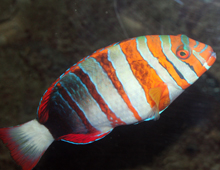Description: The Harlequin tuskfish gets its name from its garish patterns, multicolors and its protruding front tusk-like, blue teeth. Thin blue lines separate the wider bands of orangish-red, silver to somewhat greenish colors. The colors darken with age. Black eyespots on their red with blue stripe fins serve to draw potential predator’s attention to less vulnerable parts of their body. Eyes that move independently of each another and aid in surveying for both predators and prey.
Size: Adults are between 8-12 inches (20-30 cm).
Behavior: Despite their looks, they are somewhat solitary and shy but can be aggressive and territorial if needed, particularly when males are protecting their harems from other males. Adults will usually live together in small groups in caves or sloping reef areas.
Diet: The diet of these carnivores consists of many benthic invertebrates, such as worms, crabs, starfish, shrimp, slugs and mussels.
Senses: The large, independently moving eyes are used for finding food and their lateral line system detects water movement.
Communication: Their appearance is believed to be a means of announcing “no trespassing” into their space.
Reproduction: There will be one dominant male to a harem of females. If something happens to this
male, the largest female usually changes into a male. Spawning occurs in open water where a large amount of pelagic eggs will drift in the currents and settle in a reef or seagrass bed.
Habitat/range: Found in coral reefs throughout the Indo-Pacific, from East Africa, Madagascar, Maldives, Fiji and Australia.
Status: Listed as Least Concern by IUCN.



